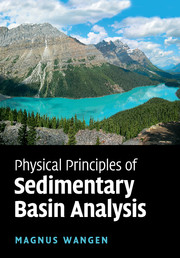Book contents
- Frontmatter
- Contents
- Preface
- Acknowledgments
- 1 Preliminaries
- 2 Properties of porous media
- 3 Linear elasticity and continuum mechanics
- 4 Compressibility of rocks and sediments
- 5 Burial histories
- 6 Heat flow
- 7 Subsidence
- 8 Rheology: fracture and flow
- 9 Flexure of the lithosphere
- 10 Gravity and gravity anomalies
- 11 Quartz cementation of sandstones
- 12 Overpressure and compaction: exact solutions
- 13 Fluid flow: basic equations
- 14 Fluid flow: basic equations
- 15 Wells
- Appendix: Fourier series, the discrete Fourier transform and the fast Fourier transform
- References
- Index
6 - Heat flow
Published online by Cambridge University Press: 07 May 2010
- Frontmatter
- Contents
- Preface
- Acknowledgments
- 1 Preliminaries
- 2 Properties of porous media
- 3 Linear elasticity and continuum mechanics
- 4 Compressibility of rocks and sediments
- 5 Burial histories
- 6 Heat flow
- 7 Subsidence
- 8 Rheology: fracture and flow
- 9 Flexure of the lithosphere
- 10 Gravity and gravity anomalies
- 11 Quartz cementation of sandstones
- 12 Overpressure and compaction: exact solutions
- 13 Fluid flow: basic equations
- 14 Fluid flow: basic equations
- 15 Wells
- Appendix: Fourier series, the discrete Fourier transform and the fast Fourier transform
- References
- Index
Summary
The Earth is losing heat through its surface, partly from cooling of the Earth and partly from heat generation by decay of radioactive isotopes. The heat loss from the Earth's surface is typically 0.05 Wm-2. This is much less than the influx from the Sun, which is typically 500 Wm-2 on a sunny day. However, almost all the energy received from the Sun is returned back into space as infrared radiation. The energy from the Sun powers the processes in the biosphere and in particular the water cycle (evaporation and rainfall), and it is therefore the energy source for erosion. On the other hand, the energy from the interior of the Earth drives large-scale geological phenomena like mantle convection, plate tectonics, volcanos, earthquakes and mountain building, see Figure 6.1.
In models of the heat flow and temperature in the subsurface it is important to distinguish between the crust and the mantle and also the lithosphere and the asthenosphere. The crust is the upper part of the Earth with a thickness in the range from 10 km to 70 km. It is made of more silica-rich and less-dense rocks than the mantle below. The crust has typical densities in the range from 2700 kgm-3 to 2900 kgm-3, and the mantle has a typical density 3300 kgm-3. The crust is therefore both chemically and mechanically different from the mantle.
The lithosphere is the outermost part of the Earth which is considered rigid, and where heat transfer is by conduction. This part extends down to a mantle depth of 100 km to 250 km in continental areas.
- Type
- Chapter
- Information
- Physical Principles of Sedimentary Basin Analysis , pp. 105 - 193Publisher: Cambridge University PressPrint publication year: 2010



